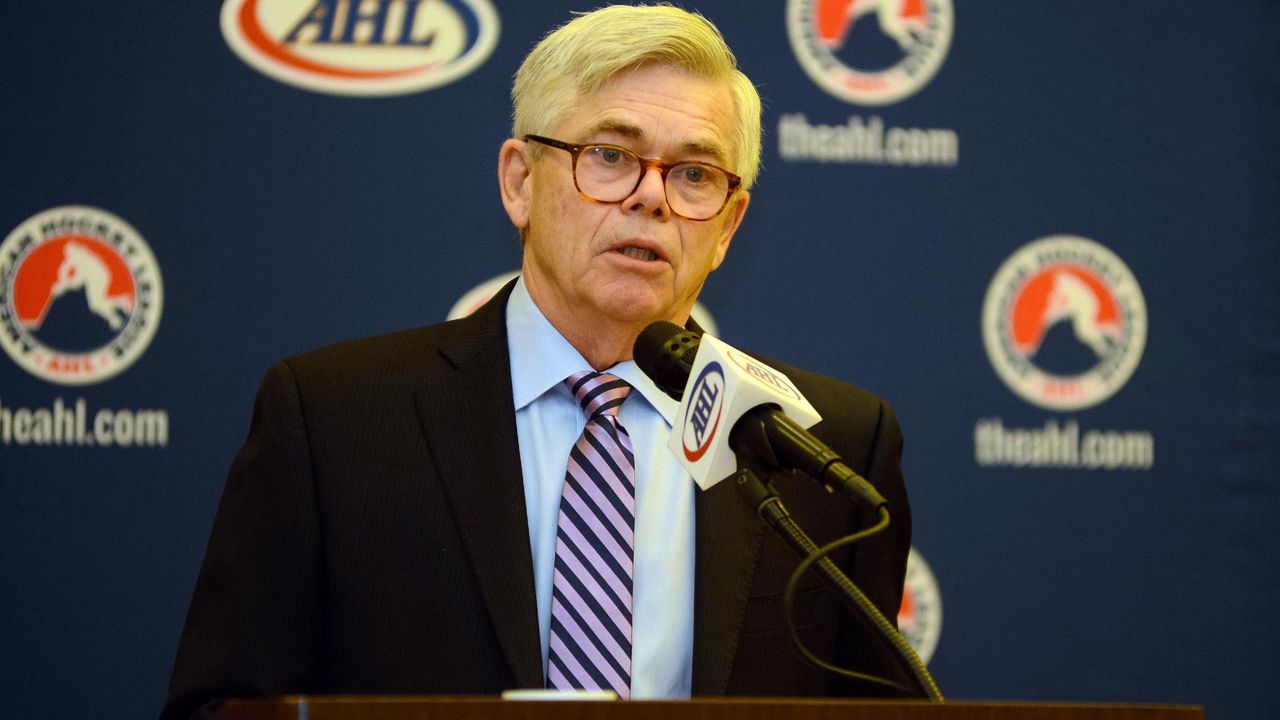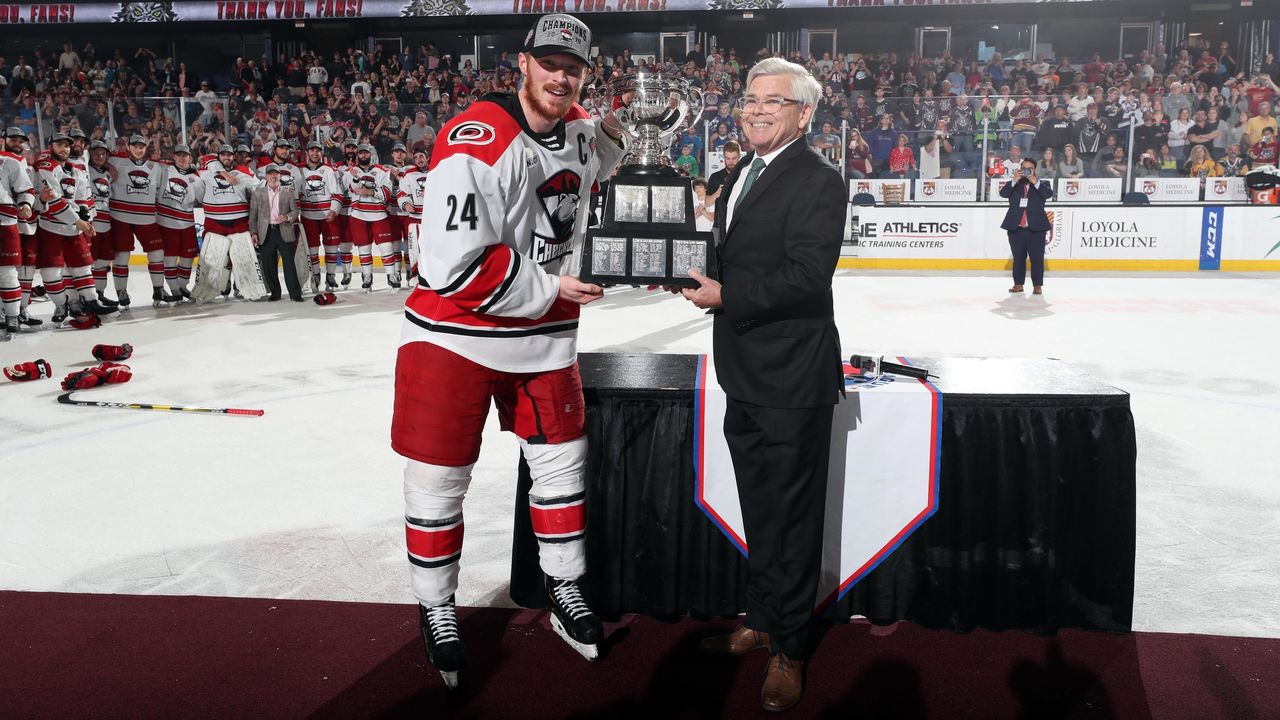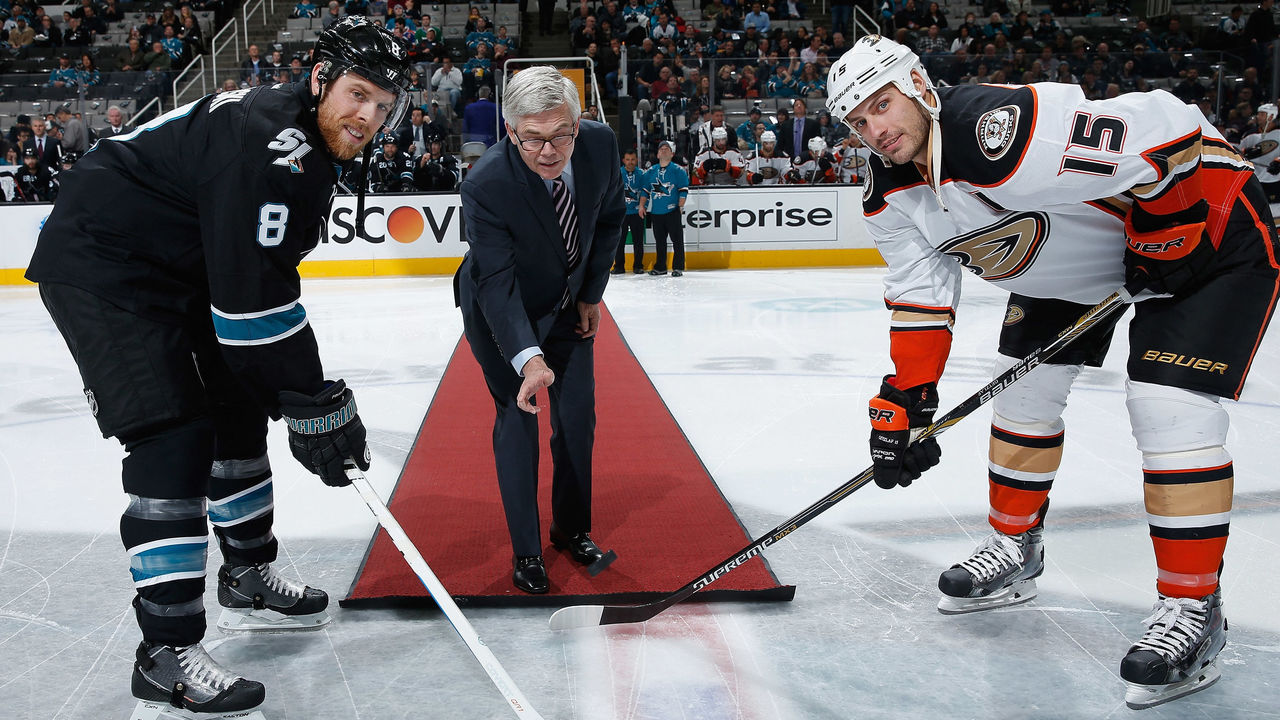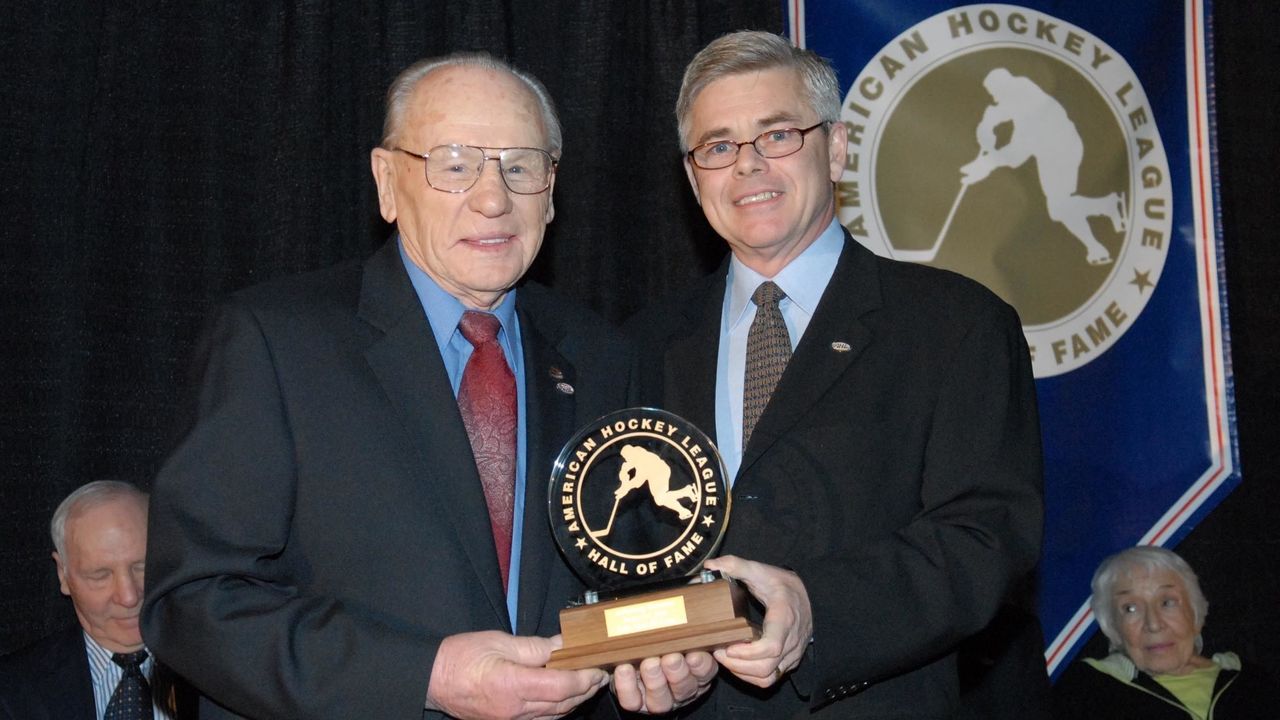The architect: Dave Andrews' patient construction framed today's AHL
Dave Andrews had it all mapped out five years ago.
After two decades presiding over the American Hockey League, he would smoothly transition into retirement, moving with his wife of 40 years, Marleen, from Massachusetts to Nova Scotia, where he grew up. Andrews even managed to sell the couple's beloved Springfield-area home to an acquaintance, allowing them to avoid real estate agent fees.
"It was a great plan," he said, "except it didn't work."
It was obvious Andrews - whose career has been defined by executed plans - was smiling over the phone as he recounted the events of early 2015. The gigantic headache that was the creation of the AHL's Pacific Division wasn't moving along fast enough, which meant Andrews didn't feel comfortable stepping down from his highly influential post.
So, the couple recalibrated and found a house to rent. Andrews has renewed one-year contracts with the league ever since, contemplating each spring if he's ready to retire, finally.
That time has arrived. June 30 will be his last official day on the job as the AHL's longtime president and CEO.
Mind you, neither transitioning into retirement nor attempting again to move to Digby, Nova Scotia, will be easy during a global pandemic.
Over the past two months, Andrews, 71, has been staring down the stiffest test of his working life. On Monday, the AHL canceled the remainder of the 2019-20 season because of COVID-19. The Calder Cup won't be handed out for the first time in the league's 84-year history.
"I've been involved in some pretty difficult challenges over the years," Andrews said. "But I would say this is the most troubling because you just don't know where it's going.
"Strategic thinking is really about being very proactive and very well prepared for what we anticipate as future challenges. I think that has been one of my strengths. That is also why today's situation is so difficult - so many uncertainties."

The decision to cancel the season wasn't Andrews' call. He deferred to government and public health officials, developing a strong feeling in mid-March that the AHL would not finish the season. Andrews and his successor as league president, former Columbus Blue Jackets general manager and outgoing Edmonton Oilers executive Scott Howson, have turned their attention to blue-skying the 2020-21 campaign.
"We have to be very flexible and understand there may be teams who can play before the rest," Andrews said of what may be varying crowd-restriction policies in the AHL's 31 markets. "We need to be flexible enough to allow that to happen in some format. Once everybody can play - or most of everybody can play - we get into our regular season."
Andrews, the architect of a sustainable, profitable AHL, will stay on as chairman of the board for three years and continue to advise Howson through this unprecedented period. Pandemic or not, it didn't make sense for the board to let Andrews go, no strings attached. He was the perfect man for the job and the job was perfect for him.
In fact, the AHL's rise is thanks to Andrews' leadership.
Nobody who knows Andrews personally would describe him as a heavy-handed leader. He's too calculated, too rational, too prudent, too bookish.
But Andrews does possess a unique brand of toughness, the type befitting a mild-mannered professional sports executive with little patience for nonsense.
"He doesn't suffer fools gladly," is how longtime associate Mark Chipman puts it.
Back in 2001, Chipman and five other owners joined the AHL after disbanding from the International Hockey League. It didn't take long for one of the new guys - "He shall remain nameless," Chipman says, the disgust fresh to this day - to find out the hard way who was in charge during the group's first board meeting.
"He said something like, 'Well, this isn't how we did it in the IHL.' Dave, quickly and abruptly, said, 'Well, this isn't the IHL,'" recalled Chipman, executive chairman of True North Sports & Entertainment, which owns the Winnipeg Jets and Manitoba Moose.
"Dave could have been even more forceful, but it was definitely message received," Chipman continued. "So, on Day 1, we knew who was running the league, and I was thankful, frankly, that this guy got tuned because he conducted himself that way all the time. The other five of us kind of smiled at each other. It was good to feel like we were part of something strong."
Andrews' matter-of-fact response was emblematic of the AHL's mindset in the early 2000s. His ambitions as AHL president started to come into focus. The long-term plan - first imagined in 1994 when he took over for Hall of Famer Jack Butterfield - aimed to vault the AHL into its own tier amid North America's bloated minor-league hockey landscape.
First, Andrews limited the number of veteran players eligible to dress for a given game in an effort to reposition the AHL as a development league. Then, with an eye on eventually having a one-to-one affiliation relationship with the NHL, he increased the franchise count through rounds of expansion, including the watershed IHL merger.

All of this upheaval occurred at a time when animosity between the AHL and IHL was boiling over. Some AHL executives would rather have watched the IHL disappear into thin air than welcome its strongest owners into the fold. However, Andrews and Chipman saw an opportunity and slyly concocted an enticing merger agreement.
"When we got it done, the deal we put together was really attractive to our owners," Andrews said. "It was an expansion, so the teams that came in were paying a ($1-million) expansion fee, which provided relief for teams that were going to have to jump into all of this air travel to get to places like Salt Lake City and Winnipeg. We were essentially a bus league, right? This was something that would have been troubling for our teams to deal with. It took some work, but the final deal was really a win-win."
Andrews doesn't play chess, though he arguably knows his way around pro hockey's chessboard better than anyone. The master mediator has been a step or two ahead of his constituents for the bulk of two decades. He says he tries his best to ensure every party involved in an AHL business deal leaves the negotiation table satisfied.
The creation of the Pacific Division might be Andrews' finest work. It took more than two years of negotiations and lost sleep to relocate five clubs and change the ownership of another. The end product isn't perfect, with the Pacific's seven squads - five in California, plus one each in Colorado and Arizona - playing eight fewer regular-season games a year than the rest of the AHL. Yet, most NHL teams have never been so close to their prospects, a real boon in a salary-cap era of endless call-ups and demotions.
"That could have been a real trainwreck, if those teams had decided to form their own west coast league," said Rick Pych, the former governor of the San Antonio Rampage.
But Andrews was persistent and uninterested in cutting side deals, Pych said.
"At the end of the day, he's always been driven by what's best for the league collectively," he added.
Andrews has encountered a revolving door of obstacles over a 26-year run, including managing more than 230 changes in ownership, affiliation, and location. The modern AHL has at least one franchise in 15 states - 16 as of next season, when the Vegas Golden Knights relocate the Rampage to nearby Henderson, Nevada - and three provinces. Its footprint stretches across the continent, from Laval, Quebec, to San Diego.
"He's had this ability to anticipate, to see above the tree line," Chipman said.
"When those (affiliation) relationships sour - and when they do, they can sour in a hurry - then you've got to be able to move quickly and find a fix," Chipman continued. "He's always been able to do that without the hockey world going, 'Oh my god, what happened here? Why did this relationship end? Why is this team moving here?' He always seems to be ahead of it. You go to a board meeting and the problem would be solved before you even got there."
Compared to the buttoned-up major leagues, minor pro sports affords its commissioners and presidents greater access to players, and vice versa. It's closer to a grassroots organization, and the wall between the players' union and the league is usually thinner. A commissioner or president can choose to ignore or take advantage of this dynamic.
Based on Mike McKenna's experiences, Andrews took advantage. Despite a 34-year age gap, the two would meet for lunch occasionally during McKenna's career as a journeyman goalie and engaged in some friendly competition at a corporate league event.
"He's a mean tennis player," reports McKenna, who for a decade was a member of the executive committee of the Professional Hockey Players' Association (PHPA).
Andrews attended the PHPA's annual meeting each June in Orlando, where he would sit in a room filled with player reps from across the league and field complaints and concerns. He would then take the most reasonable grumbles directly to the AHL's board of governors. This pragmatic approach garnered Andrews respect inside locker rooms.
"Players who had never been to the annual meeting, who had never met Dave, would have a certain opinion of the league," said McKenna, who dressed for AHL teams in 13 different locations. "The moment they showed up to the meeting and heard everything from him firsthand, they suddenly had a very different perception of how the league was run."

Andrews was a minor-league goalie himself, albeit under different circumstances. In the early 1970s - sandwiched between three years of netminding and schooling at Dalhousie University and one year at the University of British Columbia - the 5-foot-7 Andrews took his talents to the Netherlands.
"I had a friend who was playing in Europe," Andrews said. "He said, 'You know, you're not going to play in the NHL,' and I said, 'Yeah, I know that.' 'Well, go to Europe. You'll have a great time and you'll make a little bit of money.' So I went for one year, one year became two, two became three, and three became four."
Upon his return to Canada, Andrews padded his resume with an assortment of roles, including the hockey development coordinator for the province of British Columbia, the head coach for the WHL's Victoria Cougars, and a consultant for Sport Canada. His big break arrived in the late 1980s. Glen Sather, then the general manager of the Edmonton Oilers, wanted Andrews to run the club's AHL team.
"I had a government job, I had three kids, I had tenure. It was easy to just keep doing it, but (Marleen) said, 'You know what, life's an adventure. You should do it.' Back then, the Oilers were the Oilers, right? They were in the middle of the five Cups," Andrews said.
That gig as the Cape Breton Oilers' GM led him to the AHL's top job seven years later.
The AHL has doubled in size under Andrews' watch. Palm Springs, California, will play host to the league's 32nd franchise, with the team also serving as the 20th AHL affiliate owned by its parent club when it begins play in 2021 as the affiliate for the NHL's expansion team in Seattle. Meanwhile, annual league revenues have jumped from around $25 million in the early 1990s to around $160 million in the late 2010s. Franchises valued at roughly $1 million 10 years ago are worth closer to $10 million.
The AHL promotes collaboration to keep its franchises pulling on the same end of the rope. For example, the league developed an internal analytics program that allows for a business executive from, say, the Grand Rapids Griffins to share best practices on how to retain sponsors with a colleague in another front office, like the Stockton Heat's. This program has been so successful the AHL licenses it out to the Canadian Hockey League.
"The American Hockey League, from where it was when he took over to where it is today, as a business, has progressed enormously," NHL deputy commissioner Bill Daly, Andrews' main point of contact, said. "His legacy will be as an innovator."
On the ice, the AHL has been a natural testing ground. Not every rule and safety change has made its way to NHL games, but there's a long list of graduations, such as the trapezoid, hybrid icing, mandatory visors, the puck-over-glass penalty, both four-on-four and three-on-three overtime, and awarding a point for an overtime or shootout loss.
"Our relationship with them has been so important to us," Andrews said of the NHL. "As long as it didn't jeopardize the competitive integrity of our league, why not?"
Nearly 90% of NHLers pass through the AHL. Managers, coaches, officials, and business-side employees from the minor league reach the NHL at high rates, too. Andrews is particularly proud of the league's all-around professionalism.
"He took the American Hockey League to a place where, honestly, I would have never thought," PHPA executive director Larry Landon, Andrews' bargaining adversary for 26 years, said. "He strategized, he was forward-thinking. He set out to make the AHL the best-run league outside the NHL, and did it."
Andrews has spent a total of 33 years in a high-profile AHL role, or close to half of his life.
"There's no question," he said, "a lot of my identity is tied to this."
There is no doubt Andrews will be inducted into the Hockey Hall of Fame.
His immense impact on the sport can be best viewed through the three aforementioned landscape-changing milestones: transforming the AHL into the top NHL development league, absorbing the IHL clubs, and creating the Pacific Division. He's a well-respected leader who's always had a plan in motion.

McKenna lauds Andrews' ability to find common ground between owners and players, leading to a decent living for those below the NHL, a luxury some other sports can't claim. Landon salutes his lack of ego and adaptability. Chipman believes Winnipeg wouldn't have Jets 2.0 if not for Andrews' open mind 20 years ago. Pych - who in his career dealt with leaders from a variety of sports leagues, like the G League and WNBA - counts Andrews as the best of the bunch.
The post-pandemic calendar for Andrews and his wife sounds idyllic: Nova Scotia for half of the year, Arizona or Florida for the rest; sailing, racquetball, quality time with the couple's eight grandkids. That's all while keeping one foot in the hockey world as AHL chairman, as well as serving as the chair of both the Hockey Canada Foundation and the Order of Hockey Canada.
Andrews learned five years ago that retiring from a dream job isn't an easy task. So, in a strange way, he's been prepared for an unusual end to his tenure. There will be no last handshakes at AHL headquarters, no send-off party, no farewell tour during the Calder Cup playoffs, no final walk to the exit door.
"I'll be turning a switch off rather than tapering into the exit," Andrews said, smiling over the phone once again. "It's going to be odd."
John Matisz is theScore's national hockey writer
HEADLINES
- Tocchet vexed by missed chances vs. Hurricanes: 'You gotta hit the net'
- Carbery demands slumping Caps to 'get this thing turned around'
- 1 quick thought on all 32 NHL teams at midway point of season
- Red Wings hold off Blackhawks for 6th straight victory
- Pettersson returns from 6-game absence, Demko starts in loss to Canes